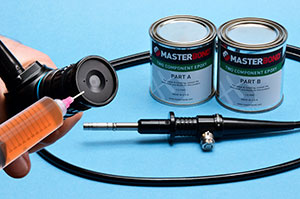 This article discusses the use of biocompatible, two-part epoxies in medical devices. When used as adhesive encapsulants these products improve the ruggedness of wire-bonded, chip-on-board microelectronic assemblies. Biocompatible products from Master Bond include EP42HT-2Med and the enhanced EP42HT-4AOMed Black product.
This article discusses the use of biocompatible, two-part epoxies in medical devices. When used as adhesive encapsulants these products improve the ruggedness of wire-bonded, chip-on-board microelectronic assemblies. Biocompatible products from Master Bond include EP42HT-2Med and the enhanced EP42HT-4AOMed Black product.
Introduction
Microelectronics devices composed of integrated circuits are complex and pose many engineering challenges. A careful design must be employed to allow heat to be dissipated from the device and mitigate thermally induced stresses. Adhesive encapsulants have been developed to seal and protect the sensitive electrical components and connections from contaminants and assist with thermal management. Encapsulants provide mechanical support, distribute stresses, and protect sensitive connections from mechanical shock. Typically, encapsulants with ceramic fillers provide enhanced thermal conductivity and improve the heat transfer and heat dissipation properties of the design, while a reduction in the thermal coefficient of expansion of the encapsulant mitigates stresses from thermal mismatch. Depending on application demands, encapsulant adhesives can be formulated for a wide range of viscosities and provide various thermal, mechanical and environmental resistance properties. Products may be engineered for application specific approvals like ISO 10993-5 and USP Class VI for use in medical devices, NASA low outgassing requirements, and cryogenic serviceability.
Uses and Thermal Properties of Encapsulants for Chip-On-Board Assemblies

In microelectronics, methods are used to form the electrical connection between an integrated circuit chip, also called a die, and the substrate. The methods of wire-bonding and flip-chip are predominantly used today. (1) An adhesive encapsulant is commonly used in these assemblies to protect the integrity of the electrical connections. The potential for thermal mismatch can be assessed by evaluating the coefficient of thermal expansion (CTE) of the materials used in the assembly. CTE may be conveniently measured as ppm/°C. Of relevance are the CTE of silicon used in the die (2.6-3.0 ppm/°C), solder (21.5-24.6 ppm/°C), and the substrate itself. A widely used organic substrate such as FR-4 exhibits a CTE of 14-17 ppm/°C. As different materials thermally expand at different rates, stresses can accumulate. Even small differences in CTE can result in premature device failure during temperature excursions. Encapsulants and underfill provide a means to mitigate thermal mismatch by distributing stresses across the coupled area and thereby minimizing the magnitude of stresses at critical solder joints. The CTE of the encapsulant itself can be optimized depending on the design requirements. Encapsulants must be electrically non-conductive and provide strong adhesion to the substrates. For demanding applications, a low CTE and moderate thermal conductivity aid in thermal management.
Citation
This article was originally published in Review of Scientific Instruments, October 2020, American Institute of Physics.DOI: 10.1063/5.0030318.
